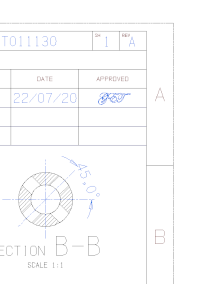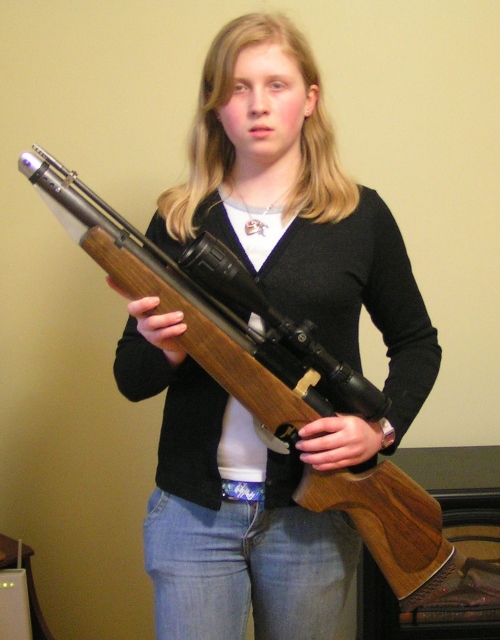GET-Designs.uk
Designing Air Weapons since 1994 in the heart of England
RFD No 55/00000002542
* 3D Models.
* CNC Produced, Prototypes.
* Detailed production drawings.
* Assistance with manufacturing techniques and tooling.
* Ongoing Technical assistance and product development.


Graham said on the 14/03/2018
Paradigm Development part 2
By Now we were into spring of 2007 and I had made the decision not to continue with the crows foot style of cocking leaver as it was not rigid enough to hold the pressures of a full power rifle when cocked. I now reverted to a more conventional type of leaver and started experimenting with various ratios of pivot point to operating angles until I found something that was not too cumbersome and felt right when in use. Another bonus of this type of leaver is that it could be concealed, in the underside of the stock.
I now began experimenting with putting the Disc Springs in the piston rod so that the head contracted under pressure during the cocking stroke and extended within the firing cycle, thus accelerating the air along the barrel behind the pellet. This involved the use of far heavier springs than had been used previously on the crows foot version since the load area was now the full diameter of the tube IE 26mm. I never cease to be amazed by the length of time it takes to find the simplest way of doing something!
I stayed with the rotary breach as it is the simplest and safest to use then started to produce a range of actions to test various valve systems both "out of balance" and "blow off" types. Whilst the out of balance valves, gave a nice feeling trigger action, they had to be kept very short to avoid the loss of propulsion volume. The blow off valves had a habit of sapping energy if the poppet was too heavy and producing recoil which whilst very small did somewhat defeat the object of producing a totally recoilless rifle.
This stage of the development program took very much longer than ever expected because every action worked well but only produced around 6 to 7 ft/lbs of energy at the muzzle. I knew that it had nothing to do with rigidity of the cocking leaver as it was now in compression unlike the previous one that had been in tension. I must admit to beginning to doubt if the 70 bar pressure was enough to do the job but stuck with it for a little longer. Plus in between development I was having to repair air rifles for local shops and make component parts for a local food producing company and even one man who was building his own private aircraft in order to keep myself and pay all the expenses.
After prolonged testing I realized that the problem was timing IE there was a time lag between the valve opening and the compression of the disc springs having the desired effect. It was vitally important to get the valve open completely as fast as possible for best results and as it turned out, a tight barrel was required, so that the pellet did not begin to move too quickly because if it did then the acceleration effect did not happen. Perhaps I should explain that the acceleration effect is caused by the ratio of the cross section area of the piston over the cross-sectional area of the barrel times the speed of the disc springs. So for a 26 mm diameter piston and a .22 barrel this ratio is in round figures 22 to 1. IE the air speed in the barrel is 22 times faster than the rate at which the piston is moving.
Trying to ascertain what is happening during a firing cycle is very difficult especially when the lock-time is so short. However, with plenty of practice I began to get a feel for it and was able to redesign and change the relevant parts to get the performance that I was looking for.

This Development Rifle was always known as the Merlin because eventually when using 21.4 grain pellets I managed to get 19 ft/lbs of energy out of this one in .22 calibre.

This is the rifle that was shown to Webley back in 2008 but they decided that, whilst they wanted a single stroke rifle, they wanted one with a Bolt Action which necessitated a completely new design being under taken as a bolt system is nowhere near as efficient as the rotary breach on this one. This actual rifle was purchased by a collector back in 2009 and it was marked up with the name and serial number at that time. It has changed hands a few times since then. Recently it has been offered up for sale in the Holts Auction on the 20th of September 2018. However, we last saw this rifle approximately 12 months ago and noted that it had been unfortunately modified and doubt if it will now perform as originally intended. Our offer to return it to original condition was declined by the then owner.

I reset its performance down to just under 12 ft/lbs to comply with the UK legal limit and at this level even my 12 year old daughter was able to cock it under my supervision. Which was astounding since she had not long ago broken her right elbow and had to do it left-handed which made me think. If she could do it than anyone old enough and big enough to use it could.

More in the series ...
From Humble Beginnings
The story behind the making of my first ever PCP.
Whirlwind CNC Rifling Machine
Reaper Development Trail
Paradigm Development part 3
Paradigm Development part 1
Twin Opposing Piston Spring Rifles Preface
3D Printing And Air Weapon Development
Nimrod Air Gun 2024
Innovate to Thrive
Velociraptor project
Fox Rifle Dynasty
Observations regarding the Webley MkII Service Rifle